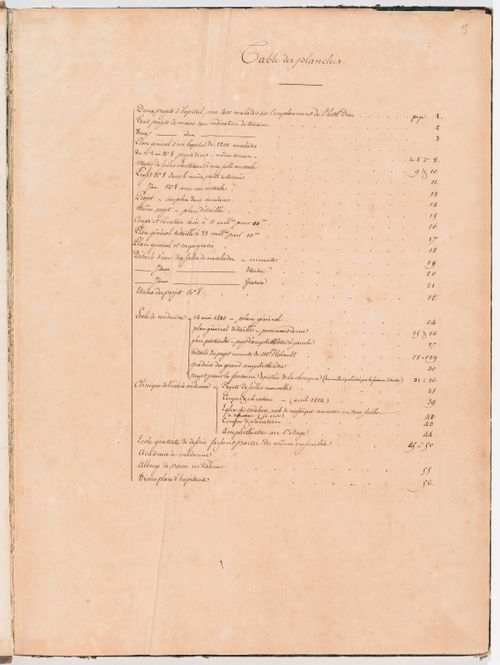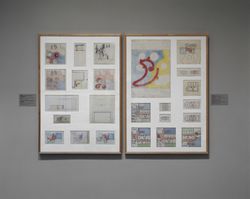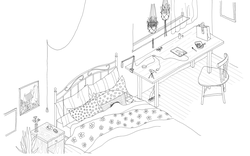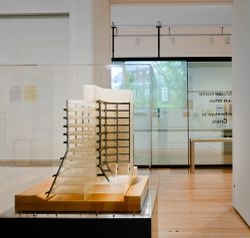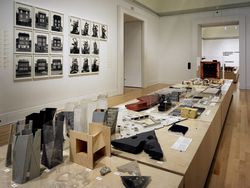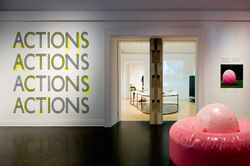textual records, photographs
AP197.S2.021
Description:
This box contains mainly chronologies that relate to architectural movements, biographical timelines of architects and the curriculum vitaes of various architects and architecture students. The largest portion of this box consists of research files arranged either by the author's last name or subject for the letter A. A large portion of texts relate to articles about Alvar Aalto and Hannah Arendt.
1965-2016
Chronologies, CVs of others, and research files organized author's last name or subject for the letter A
Actions:
AP197.S2.021
Description:
This box contains mainly chronologies that relate to architectural movements, biographical timelines of architects and the curriculum vitaes of various architects and architecture students. The largest portion of this box consists of research files arranged either by the author's last name or subject for the letter A. A large portion of texts relate to articles about Alvar Aalto and Hannah Arendt.
textual records, photographs
1965-2016
Sub-series
AP151.S1.D10
Description:
The project files documenting the construction of the Wayfarers' Chapel and site are extensive and quite complete. The documentation is more complete for the first two units of construction than for the latter units. Thus, the internal coherence of the papers is more apparent for the earlier development of the project. The most comprehensive record of the development of the Wayfarers' Chapel is contained in the "Supervision Journal" which covers the period from 1947-1971 (files 97a/97b of the "General Files"). It should be noted particularly by researchers using these papers. The research value of the "Supervision Journal" is complemented by a substantial body of general correspondence which documents Lloyd Wright's interaction with the client and with other parties involved with the design or construction of the Chapel (the Palos Verdes Corporation, the Wayfarers Chapel Building and Properties Committee, and Reverends of the Chapel between 1947 and 1960). Further correspondence relates to the publicity for the Chapel between 1951 and 1965. The textual documents are augmented by an extensive array of visual materials, such as drawings, photographs, postcards, newspaper articles and trade catalogues, which are valuable for providing a pictorial record of the Chapel and site from its earliest through to its later development. The "Trade Catalogues and Supplier Ephemera" file (file 98 of the "General Files") contains a record of the products and supplies Lloyd Wright considered or used in the construction of the Wayfarers' Chapel.
1946-1977
Wayfarers' Chapel Architect's Project Files
Actions:
AP151.S1.D10
Description:
The project files documenting the construction of the Wayfarers' Chapel and site are extensive and quite complete. The documentation is more complete for the first two units of construction than for the latter units. Thus, the internal coherence of the papers is more apparent for the earlier development of the project. The most comprehensive record of the development of the Wayfarers' Chapel is contained in the "Supervision Journal" which covers the period from 1947-1971 (files 97a/97b of the "General Files"). It should be noted particularly by researchers using these papers. The research value of the "Supervision Journal" is complemented by a substantial body of general correspondence which documents Lloyd Wright's interaction with the client and with other parties involved with the design or construction of the Chapel (the Palos Verdes Corporation, the Wayfarers Chapel Building and Properties Committee, and Reverends of the Chapel between 1947 and 1960). Further correspondence relates to the publicity for the Chapel between 1951 and 1965. The textual documents are augmented by an extensive array of visual materials, such as drawings, photographs, postcards, newspaper articles and trade catalogues, which are valuable for providing a pictorial record of the Chapel and site from its earliest through to its later development. The "Trade Catalogues and Supplier Ephemera" file (file 98 of the "General Files") contains a record of the products and supplies Lloyd Wright considered or used in the construction of the Wayfarers' Chapel.
Subseries
1946-1977
DR1974:0002:008:001-077
Description:
- This album contains prints and drawings - primarily design development and presentation drawings - mainly for projects for ideal hospitals and for the unexecuted redevelopment of the École de médecine and the surrounding area in Paris by Hubert Rohault de Fleury. Projects for ideal hospitals include: two block plans for hospitals for 400 patients on the site of Hôtel-Dieu (DR1974:0002:008:002 - DR1974:0002:008:003); nine site plans coloured with wash for hospitals for varying numbers of patients, eight of which are for a site near the barrière de Monceau (DR1974:0002:008:010 - DR1974:0002:008:014 and DR1974:0002:008:017 - DR1974:0002:008:020); five block plans for hospitals with no site indicated (DR1974:0002:008:004 - DR1974:0002:008:008); and plans, sections and elevations, most coloured with wash or watercolour, for a more developed project for an ideal hospital for 1000 to 1200 patients with no site indicated (DR1974:0002:008:022 - DR1974:0002:008:025, DR1974:0002:008:027 - DR1974:0002:008:028). The five other drawings for hospitals included in this album are apparently related to the nine site plans (DR1974:0002:008:015, DR1974:0002:008:016, DR1974:0002:008:021, DR1974:0002:008:029, and DR1974:0002:008:030). Plans, elevations and sections for the redevelopment of the area surrounding the École de médecine include the addition of a second amphitheatre to the École de médecine, an addition to the Clinique de l'École de médecine, the alteration of the École de mosaïque for use as a salle de dissection, and alterations to the École royale gratuite de dessin (DR1974:0002:008:031 - DR1974:0002:008:064). Also included are several designs for a classically-inspired fountain to be located at the entrance to the Clinique de l'École de médecine (DR1974:0002:008:042 - DR1974:0002:008:049), and drawings for the Académie de médecine, an institution which was probably housed at the École de médecine during this period (DR1974:0002:008:065 - DR1974:0002:008:068). The album includes record drawings of medical buildings by other architects: a presentation drawing of the Albergo dei poveri in Palermo, designed by Orazio Foretto Palermitano; tracings from drawings of a project for Hôtel-Dieu in Paris, designed by Charles-François Viel de Saint-Maux; the 1775 Grand Prix project for an École de médecine designed by Paul Guillaume Lemoine; prints of the the Hospice de la charité in Lyon, designed by Jean Pollet, and two hospital projects in Dijon designed by Paul P. Petit (DR1974:0002:008:069 - DR1974:0002:008:077).
architecture, topographic
first half of the 19th century
Album of drawings and prints for ideal hospitals, drawings for the redevelopment of the École de médecine and the surrounding area, Paris, and record drawings of medical buildings by French and Italian architects
Actions:
DR1974:0002:008:001-077
Description:
- This album contains prints and drawings - primarily design development and presentation drawings - mainly for projects for ideal hospitals and for the unexecuted redevelopment of the École de médecine and the surrounding area in Paris by Hubert Rohault de Fleury. Projects for ideal hospitals include: two block plans for hospitals for 400 patients on the site of Hôtel-Dieu (DR1974:0002:008:002 - DR1974:0002:008:003); nine site plans coloured with wash for hospitals for varying numbers of patients, eight of which are for a site near the barrière de Monceau (DR1974:0002:008:010 - DR1974:0002:008:014 and DR1974:0002:008:017 - DR1974:0002:008:020); five block plans for hospitals with no site indicated (DR1974:0002:008:004 - DR1974:0002:008:008); and plans, sections and elevations, most coloured with wash or watercolour, for a more developed project for an ideal hospital for 1000 to 1200 patients with no site indicated (DR1974:0002:008:022 - DR1974:0002:008:025, DR1974:0002:008:027 - DR1974:0002:008:028). The five other drawings for hospitals included in this album are apparently related to the nine site plans (DR1974:0002:008:015, DR1974:0002:008:016, DR1974:0002:008:021, DR1974:0002:008:029, and DR1974:0002:008:030). Plans, elevations and sections for the redevelopment of the area surrounding the École de médecine include the addition of a second amphitheatre to the École de médecine, an addition to the Clinique de l'École de médecine, the alteration of the École de mosaïque for use as a salle de dissection, and alterations to the École royale gratuite de dessin (DR1974:0002:008:031 - DR1974:0002:008:064). Also included are several designs for a classically-inspired fountain to be located at the entrance to the Clinique de l'École de médecine (DR1974:0002:008:042 - DR1974:0002:008:049), and drawings for the Académie de médecine, an institution which was probably housed at the École de médecine during this period (DR1974:0002:008:065 - DR1974:0002:008:068). The album includes record drawings of medical buildings by other architects: a presentation drawing of the Albergo dei poveri in Palermo, designed by Orazio Foretto Palermitano; tracings from drawings of a project for Hôtel-Dieu in Paris, designed by Charles-François Viel de Saint-Maux; the 1775 Grand Prix project for an École de médecine designed by Paul Guillaume Lemoine; prints of the the Hospice de la charité in Lyon, designed by Jean Pollet, and two hospital projects in Dijon designed by Paul P. Petit (DR1974:0002:008:069 - DR1974:0002:008:077).
architecture, topographic
textual records
AP197.S2.040
Description:
The box consists of essays, articles, publications and clippings writtin by others that relate to architecture and various architects. Architects and subjects explored include: Vittorio Gregotti; August Perret; James Stirling; Alison and Peter Smithson; Soviet architecture; Louis Kahn; and David Chipperfield.
circa 1965-2010
Unsorted essays, articles, publications, images and clippings about architecure, various architects and related subjects
Actions:
AP197.S2.040
Description:
The box consists of essays, articles, publications and clippings writtin by others that relate to architecture and various architects. Architects and subjects explored include: Vittorio Gregotti; August Perret; James Stirling; Alison and Peter Smithson; Soviet architecture; Louis Kahn; and David Chipperfield.
textual records
circa 1965-2010
articles
What, if not the family?
A Social Reset
Soirée, gala, family, what if not the family?, Miranda July, Other Architects, Grace Mortlock, David Neustein, Elena Schütz, Julian Schubert, Leonard Streich, Something Fantastic, Edit Collective, Marisa Morán Jahn, Rafi Segal, Carehaus, Johanna Hurme, 5468796 Architecture, Nahira Gerster-Sim, Frida Escobedo, Kumiko Inui, Emanuel Admasu, AD-WO
7 June 2021
What, if not the family?
Guests from multidisciplinary perspectives discuss the spatial implications of ongoing shifts in ideas of the family
Actions:
A Social Reset
Paul Nelson (1895–1979), American architect, film set designer, painter, critic, and educator, taught and practised architecture in the United States and France for over fifty years. Nelson was a central figure in the development of functionalism in the 1930s and 1940s, which rejected the Beaux-Arts language in favour of technological and functional expression. The Filter(...)
Main galleries
27 March 1991 to 26 May 1991
The Filter of Reason: The Work of Paul Nelson
Actions:
Description:
Paul Nelson (1895–1979), American architect, film set designer, painter, critic, and educator, taught and practised architecture in the United States and France for over fifty years. Nelson was a central figure in the development of functionalism in the 1930s and 1940s, which rejected the Beaux-Arts language in favour of technological and functional expression. The Filter(...)
Main galleries
articles
A Social Reset
31 May 2021
Life in the Phygital Precariat: Some newly invented terms provide an introduction to contemporary realities.
Text by Isaac Harrisson, Grace Mortlock, Lindsay Mulligan, and David Neustein, Other Architects. Illustrations by Isaac Harrisson.
Actions:
articles
31 May 2021
A Social Reset
Architect James Frazer Stirling’s work has resisted characterization because of its radical shifts in influence, named by others as prewar modernism to Neoclassicism, Rationalism and Brutalism to Postmodernism. But the continuity of his thinking emerges through the quantity and variety of material in the James Stirling/Michael Wilford Archive, a tool for understanding an(...)
Main galleries
16 May 2012 to 14 October 2012
Notes from the Archive: James Frazer Stirling
Actions:
Description:
Architect James Frazer Stirling’s work has resisted characterization because of its radical shifts in influence, named by others as prewar modernism to Neoclassicism, Rationalism and Brutalism to Postmodernism. But the continuity of his thinking emerges through the quantity and variety of material in the James Stirling/Michael Wilford Archive, a tool for understanding an(...)
Main galleries
Herzog de Meuron: Archaeology of the Mind presents an exhaustive display of materials from the architects’ archive and from related collections. Referencing a natural history, the exhibition includes study models, books, photographs, toys, fossils, Chinese scholars’ rocks, and significant works of contemporary art, all of which have informed the thinking of the Swiss(...)
Main galleries
23 October 2002 to 6 April 2003
Herzog & de Meuron: Archaeology of the Mind
Actions:
Description:
Herzog de Meuron: Archaeology of the Mind presents an exhaustive display of materials from the architects’ archive and from related collections. Referencing a natural history, the exhibition includes study models, books, photographs, toys, fossils, Chinese scholars’ rocks, and significant works of contemporary art, all of which have informed the thinking of the Swiss(...)
Main galleries
Seemingly common activities such as walking, playing, recycling, and gardening are pushed beyond their usual definition by the international architects, artists, and collectives featured in the exhibition. Their actions push against accepted norms of behaviour in cities, at times even challenging legal limitations. The individuals and groups employ a range of approaches(...)
Main galleries
26 November 2008 to 19 April 2009
Actions: What You Can Do With the City
Actions:
Description:
Seemingly common activities such as walking, playing, recycling, and gardening are pushed beyond their usual definition by the international architects, artists, and collectives featured in the exhibition. Their actions push against accepted norms of behaviour in cities, at times even challenging legal limitations. The individuals and groups employ a range of approaches(...)
Main galleries
